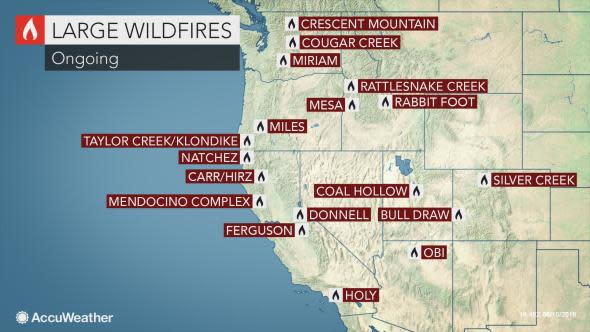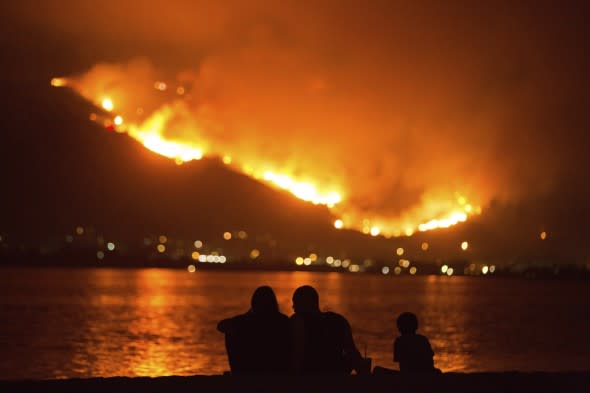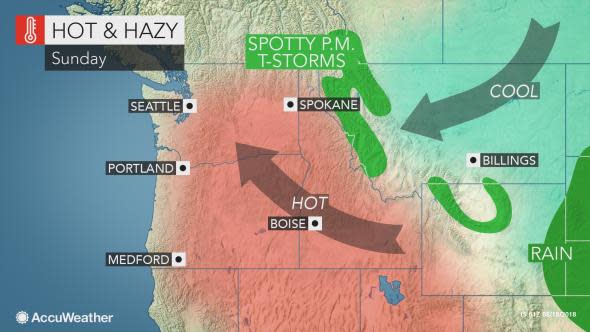No relief in sight as wildfires char millions of acres, create smoky haze in western US
The devastating western United States wildfire season may only grow worse in the coming weeks as dousing rainfall remains months away.
Over 100 large active wildfires, most of which are burning in the Western states, have charred nearly 2 million acres of land, according to the National Interagency Fire Center.

Five firefighters have died battling blazes in California, making it the deadliest season for firefighters in the state since 2008, according to SF Gate.
The blazes have fed off brush that has withered and died amid an unusually dry summer.

A family sits along the shore of Lake Elsinore as they watch the Holy Fire burn in the distance on Thursday night, Aug. 9, 2018 in Lake Elsinore, Calif. (AP Photo/Patrick Record)
Since the middle of May, drought ranging from moderate to exceptional has grown by nearly 15 percent across the West, according to the U.S. Drought Monitor.
The Pacific Northwest has experienced the greatest increase in drought this summer.
"No big breaks in the fire weather are foreseen in the short term and in the long range," said AccuWeather Senior Meteorologist Alex Sosnowski.
A system will kick up gusty winds across parts of the Rockies into Saturday evening. While substantial rain may fall to the east, any lightning strikes from thunderstorms that erupt over the Bitterroot Mountains during this time can spark new blazes.
Lightning combined with gusty winds from the thunderstorms can create a dangerous fire situation.
The shifting blazes can further put the lives of firefighters at risk.
Residents in the area should be ready to evacuate at a moment's notice.
Less wind is expected across the northern Rockies on Sunday, but isolated thunderstorms can once again develop over the higher terrain during the afternoon.

Across the Southwest, a sweep of drier air may briefly lessen storm coverage in the area from Sunday to the early part of the new week.
On average, it takes until October and November for systems with significant rainfall to sweep through the West.
Beyond this weekend, attention will then turn to heat set to build back across the West next week.
AccuWeather Senior Meteorologist Jack Boston expects the core of the heat to be felt across the Pacific Northwest, with warmer-than-normal conditions expected to return to Seattle and Portland, Oregon. Temperatures may approach record levels along this corridor.
Gusty winds may also heighten the fire danger over the interior Northwest on Monday.
Air quality concerns to linger in the near future
With no relief from the wildfires in sight, poor air quality will continue to remain a hazard for residents, visitors and fire crews.
The smoky conditions caused by the wildfires will have a detrimental effect on air quality in many areas, according to Boston.
Smoke from wildfires in British Columbia have also been creating poor air quality in Edmonton and Calgary, Alberta.
While the system over the northern Rockies briefly whisked away the hazy conditions around Seattle and Portland, smoke and poor air quality is expected to return before the end of the weekend.
The view of the Seattle skyline earlier today from the Space Needle was just a tad different compared to that of a clear day in July. Images: @space_needle #WAwx pic.twitter.com/qDYupzC7Cv
— NWS Seattle (@NWSSeattle) August 15, 2018
While children, the elderly and those with preexisting respiratory problems will be at greatest risk of suffering ill effects from the smoke, everyone spending any length of time outdoors should use caution.
Download the free AccuWeather app to stay up to date with the latest fire weather and air quality advisories.
